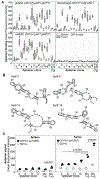Aptamers against mouse and human tumor-infiltrating myeloid cells as reagents for targeted chemotherapy
- PMID: 32554710
- PMCID: PMC9281582
- DOI: 10.1126/scitranslmed.aav9760
Aptamers against mouse and human tumor-infiltrating myeloid cells as reagents for targeted chemotherapy
Abstract
Local delivery of anticancer agents has the potential to maximize treatment efficacy and minimize the acute and long-term systemic toxicities. Here, we used unsupervised systematic evolution of ligands by exponential enrichment to identify four RNA aptamers that specifically recognized mouse and human myeloid cells infiltrating tumors but not their peripheral or circulating counterparts in multiple mouse models and from patients with head and neck squamous cell carcinoma (HNSCC). The use of these aptamers conjugated to doxorubicin enhanced the accumulation and bystander release of the chemotherapeutic drug in both primary and metastatic tumor sites in breast and fibrosarcoma mouse models. In the 4T1 mammary carcinoma model, these doxorubicin-conjugated aptamers outperformed Doxil, the first clinically approved highly optimized nanoparticle for targeted chemotherapy, promoting tumor regression after just three administrations with no detected changes in weight loss or blood chemistry. These RNA aptamers recognized tumor infiltrating myeloid cells in a variety of mouse tumors in vivo and from human HNSCC ex vivo. This work suggests the use of RNA aptamers for the detection of myeloid-derived suppressor cells in humans and for a targeted delivery of chemotherapy to the tumor microenvironment in multiple malignancies.
Copyright © 2020 The Authors, some rights reserved; exclusive licensee American Association for the Advancement of Science. No claim to original U.S. Government Works.
Conflict of interest statement
Figures







Similar articles
-
TIGIT/CD155 blockade enhances anti-PD-L1 therapy in head and neck squamous cell carcinoma by targeting myeloid-derived suppressor cells.Oral Oncol. 2021 Oct;121:105472. doi: 10.1016/j.oraloncology.2021.105472. Epub 2021 Jul 30. Oral Oncol. 2021. PMID: 34333450
-
Inhibition of JAK2/STAT3 reduces tumor-induced angiogenesis and myeloid-derived suppressor cells in head and neck cancer.Mol Carcinog. 2018 Mar;57(3):429-439. doi: 10.1002/mc.22767. Epub 2017 Dec 30. Mol Carcinog. 2018. PMID: 29215754
-
Comprehensive analysis of immune cell enrichment in the tumor microenvironment of head and neck squamous cell carcinoma.Sci Rep. 2021 Aug 9;11(1):16134. doi: 10.1038/s41598-021-95718-9. Sci Rep. 2021. PMID: 34373557 Free PMC article.
-
Smart ligand: aptamer-mediated targeted delivery of chemotherapeutic drugs and siRNA for cancer therapy.J Control Release. 2013 Oct 28;171(2):152-62. doi: 10.1016/j.jconrel.2013.06.006. Epub 2013 Jun 15. J Control Release. 2013. PMID: 23777885 Review.
-
Impact of HPV Infection on the Immune System in Oropharyngeal and Non-Oropharyngeal Squamous Cell Carcinoma: A Systematic Review.Cells. 2019 Sep 10;8(9):1061. doi: 10.3390/cells8091061. Cells. 2019. PMID: 31510065 Free PMC article.
Cited by
-
Aptamers: Cutting edge of cancer therapies.Mol Ther. 2021 Aug 4;29(8):2396-2411. doi: 10.1016/j.ymthe.2021.06.010. Epub 2021 Jun 17. Mol Ther. 2021. PMID: 34146729 Free PMC article. Review.
-
Macrophage imaging and subset analysis using single-cell RNA sequencing.Nanotheranostics. 2021 Jan 1;5(1):36-56. doi: 10.7150/ntno.50185. eCollection 2021. Nanotheranostics. 2021. PMID: 33391974 Free PMC article.
-
Targeting myeloid-derived suppressor cells for cancer therapy.Cancer Biol Med. 2021 Aug 17;18(4):992-1009. doi: 10.20892/j.issn.2095-3941.2020.0806. Cancer Biol Med. 2021. PMID: 34403220 Free PMC article. Review.
-
Immune Modulatory Short Noncoding RNAs Targeting the Glioblastoma Microenvironment.Front Oncol. 2021 Aug 31;11:682129. doi: 10.3389/fonc.2021.682129. eCollection 2021. Front Oncol. 2021. PMID: 34532286 Free PMC article. Review.
-
Identification of an Aptamer With Binding Specificity to Tumor-Homing Myeloid-Derived Suppressor Cells.Front Pharmacol. 2022 Jan 21;12:752934. doi: 10.3389/fphar.2021.752934. eCollection 2021. Front Pharmacol. 2022. PMID: 35126104 Free PMC article.
References
-
- Carvalho C, Santos RX, Cardoso S, Correia S, Oliveira PJ, Santos MS, Moreira PI, Doxorubicin: the good, the bad and the ugly effect. Current medicinal chemistry 16, 3267–3285 (2009). - PubMed
-
- Kinnear C, Moore TL, Rodriguez-Lorenzo L, Rothen-Rutishauser B, Petri-Fink A, Form Follows Function: Nanoparticle Shape and Its Implications for Nanomedicine. Chemical reviews 117, 11476–11521 (2017). - PubMed
-
- Bahrami B, Hojjat-Farsangi M, Mohammadi H, Anvari E, Ghalamfarsa G, Yousefi M, Jadidi-Niaragh F, Nanoparticles and targeted drug delivery in cancer therapy. Immunology letters 190, 64–83 (2017). - PubMed
Publication types
MeSH terms
Substances
Grants and funding
LinkOut - more resources
Full Text Sources
Other Literature Sources
Medical
Molecular Biology Databases

